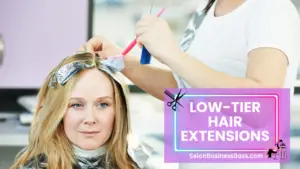Hair extensions have become a popular way for people to enhance their natural hair, add volume, and experiment with different hairstyles. The market offers a wide range of hair extensions, catering to various budgets and preferences.
Long hair extensions cost between $200 – $500, with factors like hair type, quality, and installation method influencing the price. Options range from clip-ins and tape-ins to sew-ins and micro-links. Consider your preferences and budget to find the perfect extensions for a natural and stunning look.
I. Factors Affecting Hair Extension Costs
Before delving into specific prices, it is essential to understand the factors that impact the cost of hair extensions within the $200 – $500 range. Several key elements contribute to the pricing of hair extensions:
1. Type of Hair Extensions
The type of hair extensions you choose significantly impacts the overall cost of your hair transformation. Synthetic hair extensions are generally more affordable than human hair extensions due to their manufacturing process and materials. While synthetic extensions come in a wide range of colors and styles, they lack the natural look and feel of real hair, making them a budget-friendly but less realistic option. On the other hand, human hair extensions are prized for their authenticity and versatility. Among human hair extensions, Remy hair stands out as a top-quality choice. Remy hair is collected with its cuticles intact and aligned, minimizing tangling and ensuring a smooth, natural appearance. While human hair extensions, especially Remy hair, may be more expensive, they offer superior durability, longevity, and styling options, making them a worthwhile investment for those seeking a more authentic and long-lasting hair enhancement.
2. Quality of Hair
The quality of hair used for extensions varies widely, and this directly influences the price you pay for your hair extensions. Remy hair is often considered the highest quality among human hair extensions. In Remy hair, the cuticles are preserved and aligned in the same direction, reducing tangling and ensuring a natural look and feel. As a result of this meticulous collection and processing, Remy hair extensions tend to be more expensive than non-Remy hair options. Non-Remy hair may still be suitable for some users but is typically lower in quality and may not last as long as Remy hair. When selecting hair extensions, investing in high-quality Remy hair ensures that you enjoy a beautiful, natural-looking hairstyle that maintains its integrity over time, ultimately providing excellent value for your money.
3. Length of Extensions
The length of the extensions you desire plays a significant role in determining the overall cost. Longer hair extensions require more hair to achieve the desired length, leading to a higher price tag. Shorter extensions, on the other hand, require less hair and are generally more affordable. When considering the length of your extensions, keep in mind your hair goals and the specific look you want to achieve. While longer extensions may be more expensive, they offer greater versatility and styling options. On the contrary, shorter extensions can provide volume and subtle length enhancements at a more budget-friendly price. By deciding on the desired length beforehand, you can better plan your budget and ensure that you get the perfect length for your ideal hairstyle.
4. Installation Method
The installation method you choose for your hair extensions affects the overall cost, as different methods require varying levels of labor and expertise. Clip-in hair extensions are the most cost-effective since they can be self-installed without professional help. Tape-in extensions and sew-in extensions require more skill and time for application, leading to higher costs for professional installation. Micro-link extensions involve a precise and intricate process, making them pricier than some other methods. The installation method you select should align with your lifestyle, desired level of permanence, and budget. While some methods might have a higher upfront cost, they often offer greater comfort, longevity, and a more seamless look. Ultimately, choosing a suitable installation method ensures that you achieve a secure and natural-looking hair transformation that meets your needs.
5. Brand and Reputation

The reputation and established brand name of hair extensions play a significant role in determining their cost. Reputable brands often charge a premium for their hair extensions due to their commitment to providing high-quality products, excellent customer service, and consistent satisfaction among users. Investing in a trusted brand ensures that you receive genuine, ethically sourced hair extensions that meet industry standards and undergo rigorous quality checks. While these extensions may have a higher initial cost, they offer peace of mind and a guarantee of durability and authenticity. Established brands often offer a wide range of styles, lengths, and colors, allowing you to find the perfect match for your hair goals. When considering hair extensions, it’s essential to strike a balance between price and reputation, ultimately making an informed choice that aligns with your desired hair transformation and expectations.
Read more about: Empowering Your Brand: Haircare Product Marketing
II. Types of Hair Extensions in the $200 – $500 Range
Let’s explore the common types of hair extensions available within the specified price range:
1. Clip-in Hair Extensions
Clip-in hair extensions are a popular choice among those seeking temporary hair transformations and styling versatility. These extensions are known for their user-friendly design, as they come with attached clips that allow for easy attachment and removal without the need for professional help. Ideal for special occasions or daily wear, clip-ins enable you to add length, volume, and highlights to your hair instantly. Additionally, their affordability makes them accessible to a wide range of consumers. With various lengths, textures, and colors available, clip-in extensions offer endless possibilities for creating different hairstyles. Whether you want a glamorous look for a night out or a casual everyday appearance, clip-in hair extensions provide a convenient and non-permanent solution that won’t damage your natural hair.
2. Tape-in Hair Extensions
Tape-in hair extensions are a popular choice for those seeking a semi-permanent solution that seamlessly blends with their natural hair. These extensions are applied using double-sided tape, making them lightweight and comfortable to wear. The tape lies flat against the scalp, allowing for a discreet and natural look. Tape-ins are known for their durability, as they can last up to 6-8 weeks with proper care. They are also relatively quick to apply, saving you time during the installation process. With tape-in extensions, you can enjoy the freedom to style your hair as usual, including curling, straightening, and updos, without worrying about slippage. For a low-maintenance and natural-looking hair enhancement, tape-in extensions are an excellent choice.
3. Sew-in Hair Extensions
Sew-in hair extensions, also known as weaves, are a popular option for individuals seeking a more long-term hair transformation. This method involves braiding the natural hair and then sewing the extensions onto the braids using a needle and thread. Sew-ins provide a secure attachment, making them suitable for various hair textures and styles. However, due to the intricacy of the installation process, professional assistance is recommended. Sew-in extensions offer the advantage of versatility, allowing you to wear your hair up or down while maintaining a natural appearance. They also provide added protection to your natural hair and promote healthy hair growth when maintained correctly. With proper care and regular maintenance, sew-in hair extensions can last for several weeks, offering a beautiful and natural-looking result.
4. Micro-Link (or Micro-Bead) Extensions
Micro-link extensions, also known as micro-bead extensions, offer a flexible and natural look, making them a sought-after choice among hair extension enthusiasts. These extensions are attached to the natural hair using tiny metal beads or links, which are clamped shut to secure the extensions in place. One of the benefits of micro-link extensions is that they do not require any adhesives or heat for attachment, minimizing potential damage to the natural hair. Micro-link extensions provide excellent movement and blending with your natural hair, creating a seamless look. However, this method requires professional installation due to the precision needed in placing the beads and ensuring a secure attachment. While micro-link extensions may be pricier than some other methods, their natural appearance and durability make them a worthwhile investment for those seeking a long-lasting and versatile hair transformation.
5. Flip-in (Halo) Hair Extensions
Flip-in hair extensions, also known as halo extensions, are a convenient and temporary option for adding length and volume to your hair. This type of extension consists of a wire or band attached to the extensions, which you place on top of your head like a halo. The weight of your natural hair holds the extensions in place without the need for clips or adhesive. Halo extensions can be easily applied and removed, making them a quick solution for special occasions or daily wear. They are gentle on your natural hair and do not require any professional installation, allowing you to achieve a natural and comfortable fit on your own. With halo extensions, you can instantly achieve longer and fuller hair without the commitment or potential damage associated with other methods.
III. Hair Extension Costs: Breaking Down the Range
Within the $200 – $500 price range, hair extension costs can be divided into three tiers based on the factors mentioned earlier:
1. Low-tier Hair Extensions ($200 – $300)

In the low-tier price range, hair extensions are more affordable and cater to those on a budget or seeking temporary style changes. Most extensions available in this category are made from synthetic materials or lower-quality human hair. While synthetic extensions are wallet-friendly, they may lack the natural look and feel of real hair. Human hair extensions within this range may be of lower grade, resulting in a shorter lifespan compared to higher-quality options. Additionally, the length of extensions in this range might be limited, making them more suitable for individuals looking for subtle volume or minor length enhancements. The variety of styles and colors might also be more restricted, which could limit your options when matching them to your natural hair.
Read more about: How To Start A Salon For Hair Extensions
2. Mid-tier Hair Extensions ($300 – $400)
The mid-tier price range strikes a balance between quality and affordability. Here, you can expect to find Remy human hair extensions, renowned for their cuticle alignment and natural appearance. These extensions offer a more extended lifespan and can withstand heat styling and other treatments. In this range, you have access to various installation methods, including tape-ins, sew-ins, and micro-links, giving you the flexibility to choose the best fit for your preferences and lifestyle. Reputable brands often offer extensions in this price range, ensuring that you receive reliable customer support and a wide array of lengths, textures, and colors to select from. The mid-tier range is an excellent choice for those seeking durable and natural-looking hair extensions without breaking the bank.
3. High-tier Hair Extensions ($400 – $500)
At the high-tier price range, you’ll encounter premium Remy hair extensions of exceptional quality and longevity. These extensions boast a higher grade of human hair, maintaining their luxurious texture and shine over time. The length options within this range are often more generous, allowing you to achieve dramatic transformations and create intricate hairstyles. High-tier extensions usually come from renowned brands known for their commitment to excellence, ensuring a reliable and satisfactory purchase. The installation methods employed for high-tier extensions are typically more sophisticated, providing a seamless and durable result. If you desire a flawless and natural-looking hair transformation that can withstand regular styling and handling, investing in high-tier hair extensions will offer an unparalleled experience in hair enhancement.
IV. Additional Costs to Consider
When budgeting for hair extensions, keep in mind that there might be additional costs involved:
1. Professional Installation
For a flawless and long-lasting hair extension application, professional installation is often recommended. While clip-in extensions offer a DIY option, other methods like tape-ins, sew-ins, and micro-links require the expertise of a skilled stylist. The cost of professional installation can vary based on the salon’s reputation, the stylist’s experience, and your geographic location. In metropolitan areas or high-end salons, prices may be higher. However, investing in professional installation ensures a seamless blend with your natural hair, reducing the risk of damage and ensuring a comfortable fit. Moreover, a professional stylist can provide personalized recommendations based on your hair type and lifestyle, ensuring that you achieve the desired look.
2. Maintenance and Upkeep
Maintaining hair extensions is essential to preserve their quality and appearance. Regular maintenance includes scheduling periodic appointments with your stylist to check for any loosening or matting of the extensions. Shampooing and conditioning your hair extensions with appropriate products will keep them clean and soft. Avoid using products containing sulfates or alcohol, as these can damage the extensions. Gently brush your extensions daily to prevent tangling and shedding. Depending on the method of installation and your natural hair growth, you may need to visit your stylist every 4 to 6 weeks for adjustments to maintain a secure fit. By following a proper maintenance routine, you can extend the lifespan of your extensions and enjoy a stunning, natural-looking hairstyle for longer.
3. Styling Products

Using the right styling products is crucial to preserve the quality and longevity of your hair extensions. Invest in sulfate-free and alcohol-free shampoos and conditioners, as these are gentle on both your natural hair and extensions. Avoid products that contain silicone, as they can cause build-up and weigh down the extensions. Instead, opt for lightweight serums and leave-in conditioners to keep your extensions soft and manageable. Heat protection sprays are essential when using heat styling tools to prevent damage to the extensions. Always style your extensions on low to medium heat settings to maintain their integrity. By using suitable styling products, you can keep your hair extensions looking beautiful and healthy, making them a worthwhile investment in your hair transformation journey.
Read more about: 6 Best Products to Sell in a Hair Salon for Increased Profits
Conclusion
Hair extensions are a versatile and transformative way to achieve the desired look for your hair. Within the $200 – $500 price range, various options are available, catering to different preferences and budgets. Remember to consider the factors influencing hair extension costs, opt for the type that suits your lifestyle, and choose high-quality extensions for a long-lasting and natural look. Whether you seek length, volume, or a temporary style change, well-chosen hair extensions can be a game-changer in your hair journey.
Frequently Asked Questions

1. Are maintenance costs included in the initial price of hair extensions?
Maintenance costs, such as adjustments, shampoo, and conditioning, are typically separate from the initial price of hair extensions.
2. Do reputable brands justify higher prices for hair extensions?
Yes, reputable brands often offer superior quality, customer support, and a broader range of styles, justifying their higher prices.
3. Can I find long hair extensions within the $200 – $500 range?
Yes, long hair extensions are available in this price range, but factors like quality and installation method may influence the final cost.
To learn more on how to start you own salon checkout my startup documents here.
Please note that the contents of this blog are for informational and entertainment purposes only and should not be construed as legal advice. Any action taken based on the information provided in this blog is solely at your own risk. Additionally, all images used in this blog are generated under the CC0 license of Creative Commons, which means they are free to use for any purpose without attribution.

About the author. Entrepreneur and Salon Business Fan.
Hi! I am Shawn and I am a happy individual who happens to be an entrepreneur. I have owned several types of businesses in my life from a coffee shop to an import and export business to an online review business plus a few more and now I create online salon business resources for those interested in starting new ventures. It’s demanding work but I love it. I do it for those passionate about their business and their goals. That’s why when I meet a salon business owner, I see myself. I know how hard the struggle is to retain clients, find good employees and keep the business growing all while trying to stay competitive.
That’s why I created Salon Business Boss: I want to help salon business owners like you build a thriving business that brings you endless joy and supports your ideal lifestyle.

